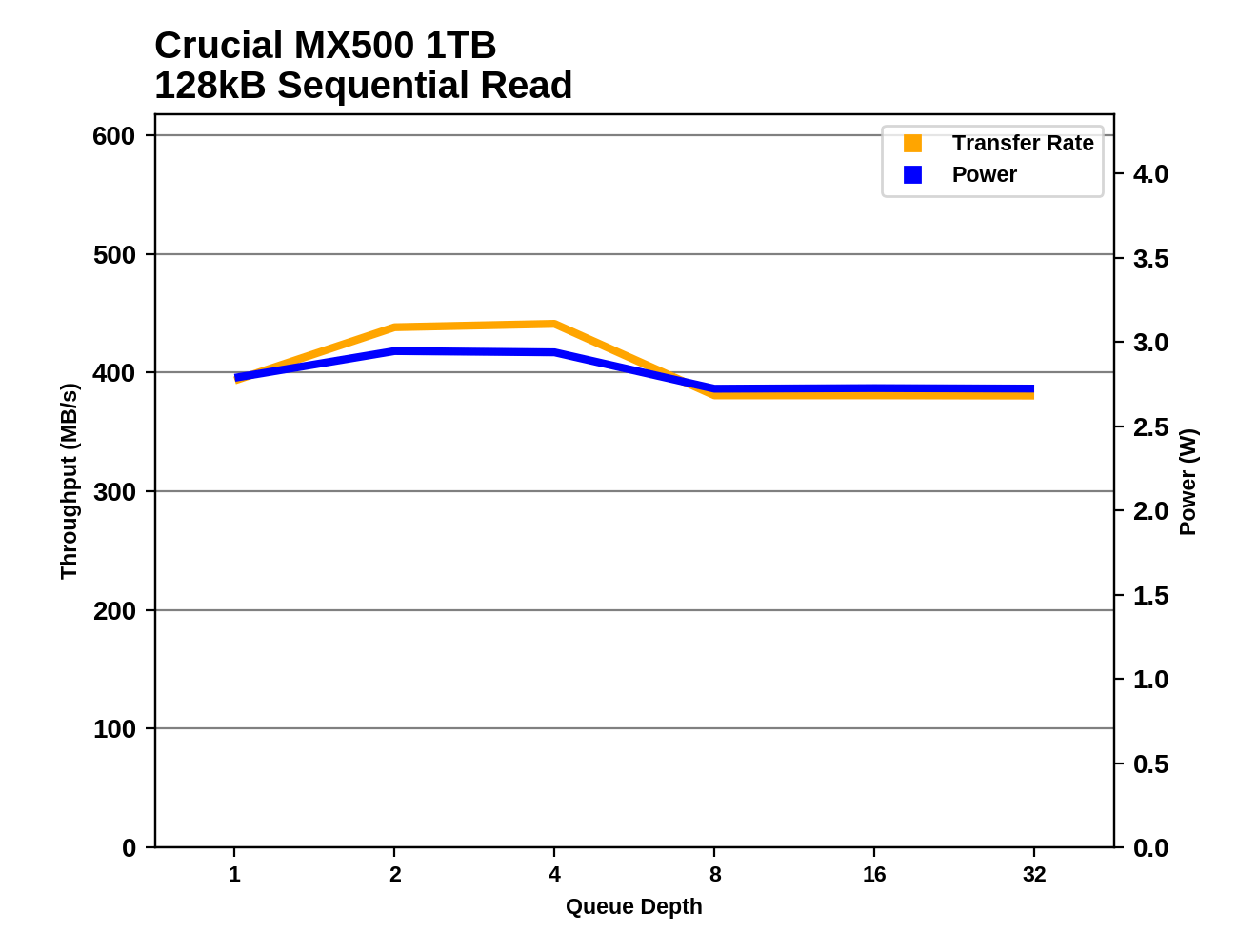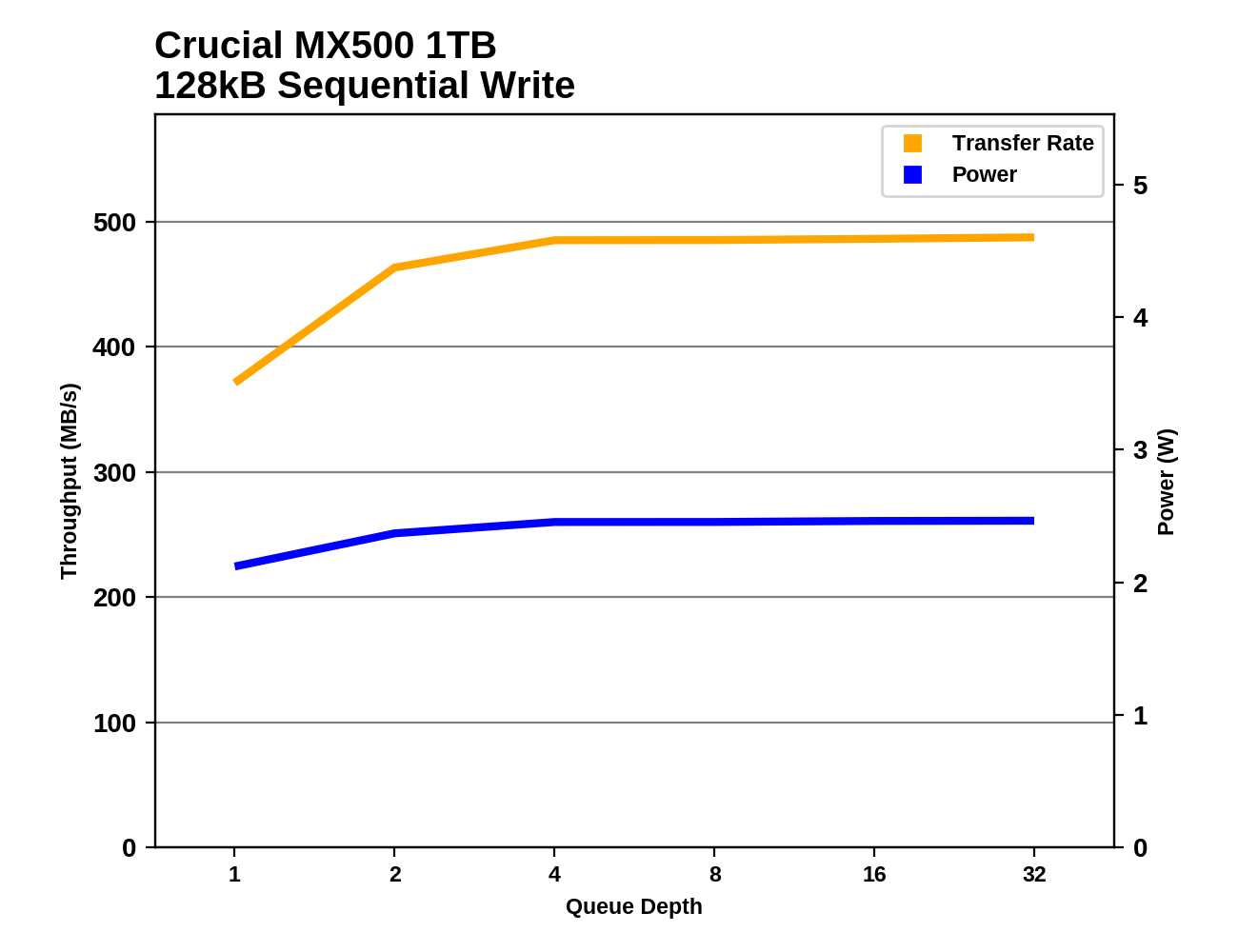The Crucial MX500 1TB SSD Review: Breaking The SATA Mold
by Billy Tallis on December 19, 2017 8:00 AM ESTSequential Read Performance
Our first test of sequential read performance uses short bursts of 128MB, issued as 128kB operations with no queuing. The test averages performance across eight bursts for a total of 1GB of data transferred from a drive containing 16GB of data. Between each burst the drive is given enough idle time to keep the overall duty cycle at 20%.

The Crucial MX500 turns in another record-setting burst performance score with its sequential read results, but by the smallest margin yet. It's about 6% faster on this test than most mainstream SATA SSDs.
Our test of sustained sequential reads uses queue depths from 1 to 32, with the performance and power scores computed as the average of QD1, QD2 and QD4. Each queue depth is tested for up to one minute or 32GB transferred, from a drive containing 64GB of data.

The sustained sequential read performance of the Crucial MX500 puts it in second place, behind the Samsung 850 PRO and 850 EVO. The MX500 does have a slight advantage over the other 64L 3D TLC drives, and improves on the MX300's performance by an impressive 100 MB/s.

The power efficiency of the Crucial MX500 during sequential reads is mediocre and clearly worse than the other 64L 3D TLC drives, including the Intel 545s. The MX500 is slightly more efficient than the Samsung 850 PRO and EVO, and scores 21% higher than the MX300.
 |
|||||||||
The Samsung 850 PRO and EVO are the only drives that continuously saturate the SATA bus from QD2 onwards with no drops in performance. The MX500's performance is reasonably steady but does drop a bit as the test wears on.
Sequential Write Performance
Our test of sequential write burst performance is structured identically to the sequential read burst performance test save for the direction of the data transfer. Each burst writes 128MB as 128kB operations issued at QD1, for a total of 1GB of data written to a drive containing 16GB of data.

For once, the burst performance of the Crucial MX500 doesn't set a record. Its QD1 sequential write speed is only second-fastest, about 3% slower than the Samsung 850 PRO.
Our test of sustained sequential writes is structured identically to our sustained sequential read test, save for the direction of the data transfers. Queue depths range from 1 to 32 and each queue depth is tested for up to one minute or 32GB, followed by up to one minute of idle time for the drive to cool off and perform garbage collection. The test is confined to a 64GB span of the drive.

The sustained sequential write speed of the MX500 is the same as the MX300, putting them in the second tier of performance behind the Samsung 850 PRO and EVO and the MLC-based Patriot Ignite.

The Crucial MX500 scores great on power efficiency during sequential writes, but not quite as well as the MX300. The OCZ VX500 with its reduced DRAM cache holds on to first place and the Toshiba TR200 (entirely DRAMless) comes in right behind the MX500. The mainstream 3D TLC drives are all much less efficient.
 |
|||||||||
Only a few drives offer a higher sustained sequential write speed than the MX500 after reaching saturation. The Samsung drives and the Patriot Ignite are faster at all queue depths and much less pwoer efficient than the MX500, while the OCZ VX500 stumbles at QD2 before saturating with slightly higher throughput and substantially lower power consumption. The MX300 is a bit faster than the MX500 at QD2 but slightly slower at higher queue depths.










90 Comments
View All Comments
StrangerGuy - Tuesday, December 19, 2017 - link
Hey let's pay >3x/GB for SLC so we can have extra drive endurance where TLC already doesn't matter for 99.999% of the target market, of course he's the smart one and rest of us are teh dumbs.10TB written over 3.5 years on my M550 1TB, yup can't wait for the drive to finally die in 300 years if it was *only* 1000 writes/bit TLC so I can buy a new one. Because TLC endurance sux amirite?
PeachNCream - Tuesday, December 19, 2017 - link
TLC is pretty good these days compared to planar MLC from 2012. You probably wouldn't have anything to worry about since a drive like the MX500 would be obsolete before endurance becomes a problem. But if you're worried, there's the BX300 that's still for sale like MajGenRelativity suggested. Mushkin was also selling a 3D MLC drive, the Reactor Armor3D that was released in January-ish of this year. They have a 1TB model available and it uses the same Silicon Motion SM2258 controller so you'd probably see similar performance.https://www.anandtech.com/show/11035/mushkin-launc...
ddrіver - Tuesday, December 19, 2017 - link
BS. This study proved SLC and MLC aren't actually meaningfully different. By inference TLC is good enough for almost anything. If you're the kind of person who can't do with TLC it's either overstating your usage scenarios or you're in the NAND destruction business.https://www.usenix.org/conference/fast16/technical...
mode_13h - Tuesday, December 19, 2017 - link
I wouldn't get so hung up on # of bits per cell. What matters is performance, write endurance, and (for some use cases) power-off data retention.mode_13h - Tuesday, December 19, 2017 - link
I'm really impressed with the QD1 random read performance of this drive. I didn't think you could achieve so many QD1 IOPS with SATA, or else Samsung probably would've done it.DoveOfTheSouth - Wednesday, December 20, 2017 - link
The QD1 results are impressive in the tables but the charts seem to show lower figures (QD1 read: 44.7 v c. 35; write 164.2 v c. 146). Which is correct?StrangerGuy - Tuesday, December 19, 2017 - link
The only thing that really matters is the 4K QD1 benchmark and that was extremely impressive for the asking price.shatteredx - Thursday, January 11, 2018 - link
Agreed. MX500 hard to beat for the price now.LordConrad - Wednesday, December 20, 2017 - link
"With the MX500 arriving at $259.99 for the same capacity but with a longer warranty..."The Samsung 850 EVO and Crucial MX500 both have a 5-year warranty.
diceman2037 - Thursday, September 2, 2021 - link
Unfortuantely, what this review couldn't account for was these SSDs have a serious defect where uptimes correlate to significant increases of write amplification in comparison to their older mx300 siblings and not fit for use as an OS drive.https://forums.tomshardware.com/threads/crucial-mx...